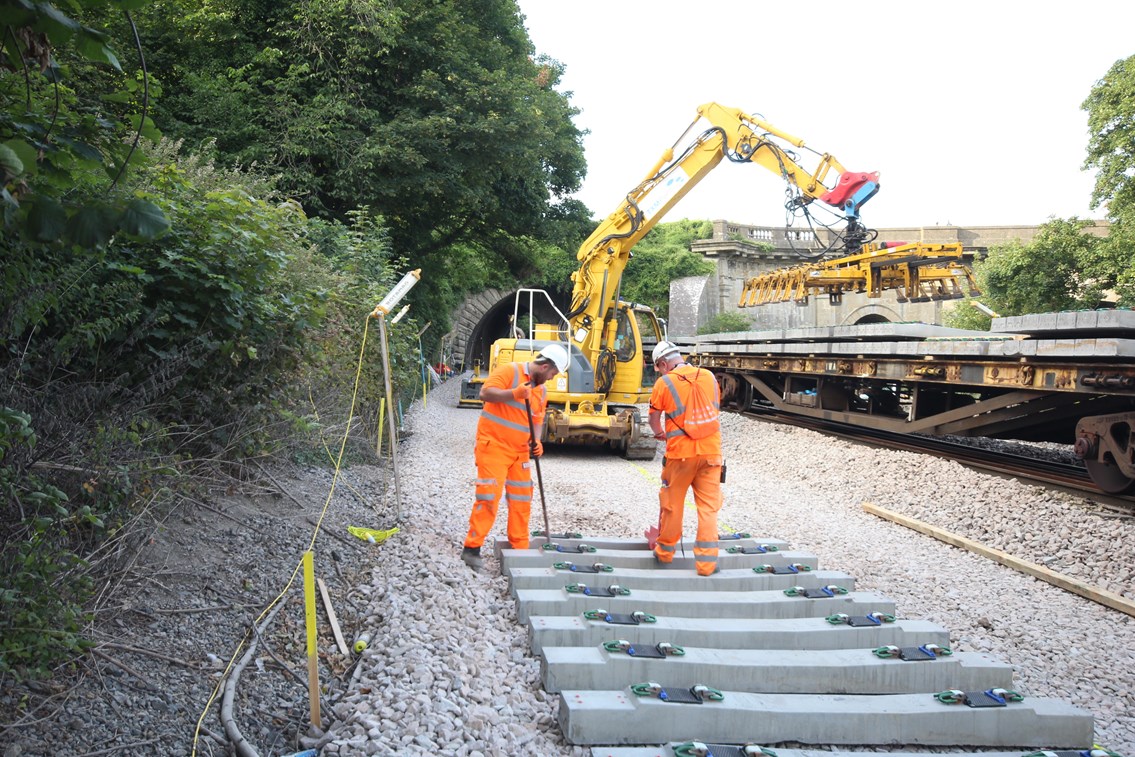Monday 17 Aug 2015
Stunning time-lapse film shows track lowering work through Dundas Aqueduct
- Region & Route:
- | Wales & Western: Western
- | Wales & Western
As Network Rail’s ‘orange army’ pass the halfway point in the project to prepare Bath’s railway line for electrification, this stunning time-lapse photography shows the scale of the work to lower the track through the historic Dundas Aqueduct.
In total, the ‘orange army’ is lowering 10km of track through Bath and its surrounding area to protect Bath’s historic architecture whilst making room for the overhead lines that will power a new fleet of longer, faster, quieter and greener electric trains to run underneath.
The majority of the work at Dundas Aqueduct was completed over the weekend of 8-9 August and involved lowering approximately 1.5km of track. This will provide the clearance necessary to ensure a lower line speed will not have to be put in place through Dundas Aqueduct for the diesel trains that will be cascaded from the Thames Valley to service the valley branch lines once the new electric trains begin servicing the Great Western Main Line.
These particular diesel trains are longer, enabling passengers to benefit from more seats while maintaining journey times. The track lowering work will also enable this branch line to be used as a diversionary route for freight services in the future.
Andy Haynes, Network Rail’s project director for the west of England, said: “We have reached a major milestone in our work to prepare Bath’s railway line for electrification. Not only are we past the halfway point and still on schedule, but one of the most complex aspects of our track lowering work is now complete.”
As the ‘orange army’ head into the final phases of the project, work has started to lower the main line that runs from London Paddington towards the South West, while the team continues its work to lower the tracks at Bathampton Junction.
This work has presented its own challenges, including the need to remove more waste material from the site at Bathampton Junction than anticipated. However, the team’s contingency plans meant an additional train to carry the waste material away from the site was available to be sent in at short notice.
Andy continued: “This is a challenging project, but I’m pleased to say we remain on schedule for reopening the line on 1 September.
“We apologise for any inconvenience caused as a result of our work, but the arrival of electrification and the new fleet of electric trains will have many long-term benefits for both passengers and those who live close to the railway line, as well as boosting economic growth across the South West.”
ENDS
Notes to editors
Further travel information for during the Bath work can be found by visiting First Great Western’s website www.firstgreatwestern.co.uk. Alternatively, National Rail Enquiries also has up-to-date travel advice on their website www.nationalrail.co.uk.
For the latest information on the Bath electrification work, follow our Twitter account @networkrailgwrm.
Contact information
Passengers / community members
Network Rail national helpline
03457 11 41 41
Latest travel advice
Please visit National Rail Enquiries
Journalists
Victoria Bradley
Media relations manager (Western route)
Network Rail
01793 389749 / 07710 938470
victoria.bradley@networkrail.co.uk
About Network Rail
We own, operate and develop Britain's railway infrastructure; that's 20,000 miles of track, 30,000 bridges, tunnels and viaducts and the thousands of signals, level crossings and stations. We run 20 of the UK's largest stations while all the others, over 2,500, are run by the country's train operating companies.
Usually, there are almost five million journeys made in the UK and over 600 freight trains run on the network. People depend on Britain's railway for their daily commute, to visit friends and loved ones and to get them home safe every day. Our role is to deliver a safe and reliable railway, so we carefully manage and deliver thousands of projects every year that form part of the multi-billion pound Railway Upgrade Plan, to grow and expand the nation's railway network to respond to the tremendous growth and demand the railway has experienced - a doubling of passenger journeys over the past 20 years.
Follow us on Twitter: @networkrail
Visit our online newsroom: www.networkrailmediacentre.co.uk

